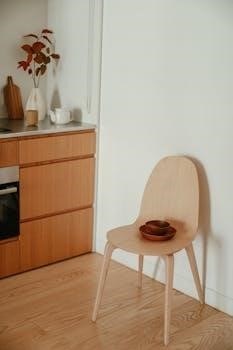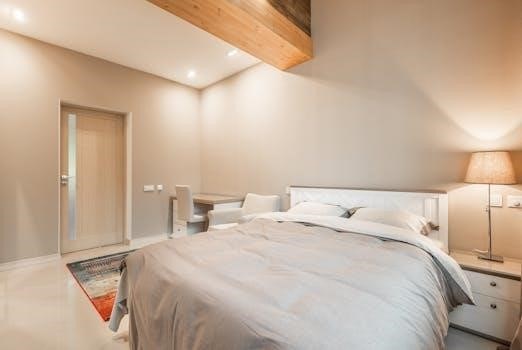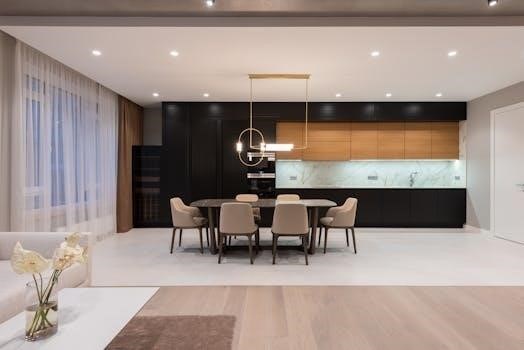Embarking on a kitchen remodel can be daunting‚ but with well-structured wall cabinet plans‚ it is manageable․ This guide will navigate standard cabinet dimensions‚ crucial for optimized functionality‚ storage‚ and aesthetics․ Understanding these will be a key in your next renovation project․
Importance of Accurate Measurements
Accurate measurements are paramount when utilizing wall cabinet plans‚ especially when you consider the impact on your kitchen layout․ Precise dimensions ensure seamless integration of cabinets within your designated space‚ preventing costly errors and rework․ Incorrect measurements can lead to cabinets not fitting properly‚ resulting in gaps‚ misalignments‚ and a diminished overall look․ Furthermore‚ proper measurements are critical when dealing with custom-made cabinetry‚ as they will not be standard sized․ Knowing the correct dimensions helps optimize every inch of your kitchen‚ maximizing functionality and storage․ When preparing for a kitchen renovation‚ measuring accurately is the first and most important step․ This includes measuring not only the space for the cabinets‚ but also any trim or molding that might affect their placement․ By ensuring your measurements are precise‚ you are setting the foundation for a successful and efficient kitchen renovation that meets both your functional needs and stylistic preferences․

Standard Wall Cabinet Dimensions
Understanding standard dimensions for wall cabinets is crucial for effective kitchen planning․ This section explores common heights‚ depths‚ and width options․ These are the building blocks of well-designed kitchen cabinetry․
Common Heights for Wall Cabinets
Wall cabinets typically come in several standard heights to accommodate various kitchen designs and ceiling heights․ The most common heights are 12‚ 15‚ and 18 inches‚ though options can extend up to 42 inches for taller spaces․ The choice of height largely depends on the desired look and the space between the countertop and the lower edge of the wall cabinets․ A common practice is to leave around 18 inches of space‚ but this can vary based on personal preference․ Shorter cabinets are suitable for areas with lower ceilings‚ while taller ones provide more storage․ It is also common to run full-height cabinets to the ceiling for a seamless look․ These dimensions help in planning kitchen layouts‚ considering both aesthetic appeal and storage needs․ The height you select should also consider the intended use and accessibility of the items you plan to store within them․
Typical Depth of Wall Cabinets
The standard depth for wall cabinets is generally around 12 inches․ This depth is carefully chosen to provide ample storage for common kitchen items like dishes and cereal boxes‚ while also ensuring they do not protrude too far into the room and impede movement․ However‚ it is important to note that cabinet depths can vary‚ and you may find options ranging from 15 to 24 inches․ The depth you need depends on the specific design and manufacturer‚ as well as the kitchen’s overall layout and intended functionality․ Deeper cabinets offer more storage space‚ but may require more reach․ For over-the-fridge cabinets‚ depths can be around 24 inches․ The 12-inch depth is the most common for general storage․ The goal is to balance storage with ease of access and a comfortable kitchen environment․
Standard Width Options for Wall Cabinets
Wall cabinets come in a variety of standard widths to accommodate different kitchen layouts and storage needs․ These widths typically range from 9 inches to 48 inches․ The most common increments are 3 inches‚ so you’ll often see cabinets available in widths of 9‚ 12‚ 15‚ 18‚ 21‚ 24‚ 27‚ 30‚ 33‚ 36‚ 39‚ 42‚ 45‚ and 48 inches․ Single door wall units can start from 150mm‚ while double door units come in various sizes too․ The width you choose will depend on the space available on your wall‚ the type of items you intend to store‚ and the overall design of your kitchen․ Wider cabinets can be used for larger items‚ and it’s important to choose the sizes that will best fill your space while providing the storage you need and a balanced aesthetic․

Key Considerations for Planning
When planning your wall cabinet layout‚ consider factors like ceiling height and personal preferences․ The distance between the cabinets and the ceiling must be well thought-out to achieve a clean and functional design․
Distance Between Wall Cabinets and Ceiling
The standard distance between the top of wall cabinets and the ceiling typically ranges from 12 to 18 inches․ This spacing is designed to provide easy access to the upper cabinets while maintaining a clean‚ finished look in the kitchen․ However‚ this measurement isn’t set in stone; it can be adjusted depending on the height of your ceiling and your individual design preferences․ For instance‚ in kitchens with higher ceilings‚ you might opt for a larger gap‚ or even full-height cabinets extending to the ceiling‚ to maximize storage space and create a more dramatic effect․ Conversely‚ in rooms with lower ceilings‚ a slightly smaller gap may be more suitable․ Keep in mind that the distance should also consider any crown molding or trim work‚ which can impact the final visual and functional aspects of your kitchen cabinetry․ It is very important to remember all of these when you are working on kitchen renovations․
Wall Cabinet Placement and Layout
The positioning and layout of wall cabinets significantly impact the functionality and aesthetics of your kitchen․ Standard wall cabinets are typically placed above base cabinets‚ leaving a countertop space in between․ However‚ wall cabinets don’t necessarily have to be on the wall‚ they can also be used as floor cabinets in certain cases․ The height at which wall cabinets are installed is crucial‚ usually around 18 inches above the countertop‚ to allow ample workspace․ When planning the layout‚ consider the kitchen’s workflow and the placement of appliances․ Cabinets should be strategically positioned to ensure easy access to frequently used items and to avoid any obstruction․ The layout should also allow for easy movement around the kitchen‚ avoiding any bottlenecks or awkward reaches․ The goal is to create a functional‚ cohesive and stylish space where everything is easily accessible․ It is important to take all of this into account during your renovation;

Specific Types of Wall Cabinets
Beyond standard wall cabinets‚ specific types cater to unique needs‚ such as over-the-fridge cabinets which are typically deeper‚ and cabinets designed for above microwaves‚ which might be shorter in height․
Over-the-Fridge Cabinet Dimensions
Over-the-fridge cabinets present a unique challenge and opportunity in kitchen design‚ differing significantly from standard wall cabinets․ Typically‚ these cabinets are deeper to align with the refrigerator’s depth‚ often around 24 inches‚ which contrasts with the standard 12-inch depth of typical wall cabinets․ This increased depth allows for better storage of larger items that might not fit in standard upper cabinets․ Height can vary‚ but it often depends on the refrigerator height and the overall kitchen design‚ with common heights ranging from 12 to 30 inches․ Widths are determined by the refrigerator size‚ ensuring a seamless‚ built-in look․ These dimensions must be meticulously planned to maximize space‚ avoid awkward gaps‚ and maintain visual harmony in the kitchen layout․ In general‚ accuracy in these dimensions is extremely important․
Dimensions for Cabinets Above Microwaves
Cabinets designed for placement above microwaves require careful dimensioning to ensure both functionality and safety․ Typically‚ these cabinets are shallower than over-the-fridge units‚ usually ranging from 15 to 18 inches deep․ This reduced depth accommodates standard microwave depths without protruding excessively․ Height is another crucial factor‚ often planned to provide adequate clearance above the microwave for ventilation and easy access; common heights range from 12 to 18 inches․ The width of these cabinets usually aligns with the width of the microwave‚ creating a balanced look․ It’s essential to consider the specific microwave model’s dimensions when planning these cabinets to guarantee a perfect fit and prevent any installation issues․ Accurate measurements here will prevent issues in the long run․

Practical Tips for Using PDF Plans
When using PDF plans‚ carefully review all dimensions‚ noting height‚ depth‚ and width; Double check each measurement with your space‚ as even minor discrepancies can lead to major problems later․ Always verify the scale․
Understanding Measurements in PDF Plans
Comprehending measurements within PDF plans is crucial for successful cabinet installation․ These plans typically detail dimensions in inches or millimeters․ Height refers to the vertical measurement‚ depth indicates the distance from the front to the back‚ and width measures side to side․ Pay close attention to these three numbers‚ as they directly impact the fit and functionality of your cabinets․ Note that measurements for wall cabinets can vary from 12 to 42 inches in height‚ typically 12 inches in depth‚ and 9 to 48 inches in width‚ usually in 3-inch increments․ Check for overall cabinet dimensions and also the dimensions of individual parts․ PDF plans also usually specify door dimensions‚ which are important for ensuring proper door installation․ Understanding the scale of the plan is also essential‚ as this ensures that the printed plan accurately reflects the real-world measurements․ Always double-check the measurements to ensure accuracy‚ and cross-reference the plans with the actual space where the cabinets will be installed to avoid costly mistakes․



